Part III Assistance for Each Region
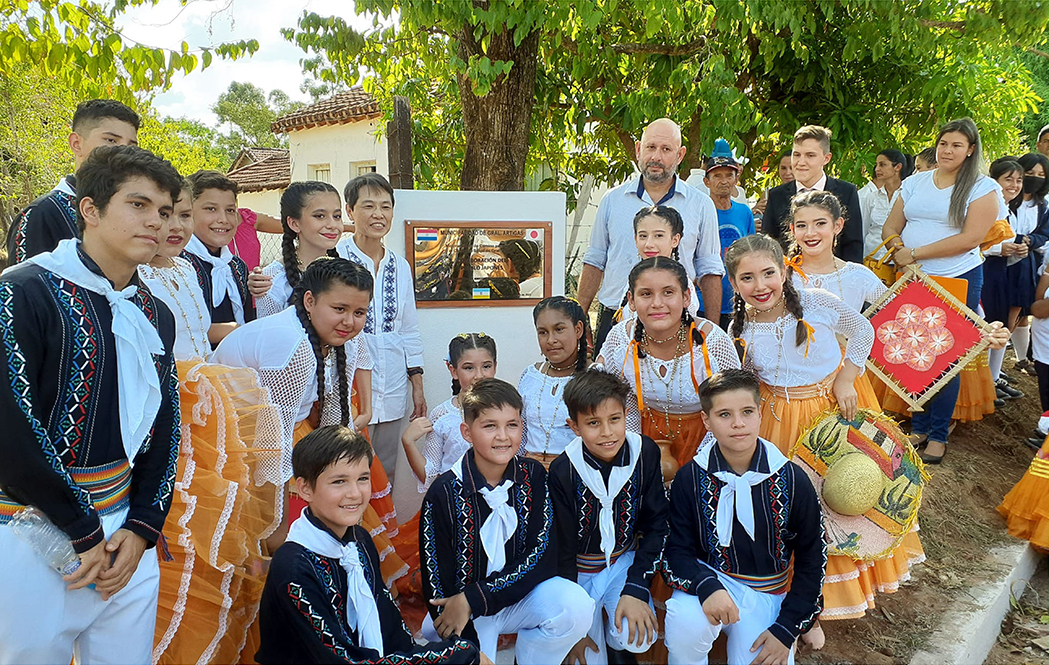
Local residents and Ms. Nakatani, Ambassador of Japan to Paraguay, celebrating the completion of the road at the inauguration ceremony for the Grant Assistance for Grass-Roots Human Security Project, “Artigas Community Health Center Access Road Construction Project” implemented in General Artigas District, Itapua Department of Paraguay
1 East Asia
East Asia consists of a variety of nations, which include least developed countries (LDCs) such as Cambodia and Laos; countries such as Indonesia and the Philippines, which still face large income disparities domestically despite significant economic growth; and countries such as Viet Nam, which are transitioning to a market-driven economy.
Japan has established political, economic, and cultural relations with these countries, which are located at the center of the Indo-Pacific region. The region’s stability and development are directly linked to the security and economic prosperity of Japan. Based on this perspective, Japan engages in development cooperation that responds to the diverse socio-economic circumstances of East Asian countries and to the changing context of cooperation required.
● Japan’s Efforts
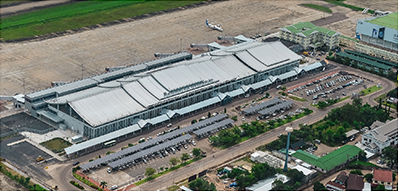
Vientiane Wattay International Airport in Laos with expanded and improved facilities to respond to increasing passenger demand (Photo: JICA)
Japan has contributed to the remarkable economic growth of East Asia by implementing development cooperation that combines ODA with trade and investment, including the development of socio-economic foundations through quality infrastructure investment, support for the development of institutions and human resources, promotion of trade, and revitalization of private investment. In recent years, Japan aims to further enhance open regional cooperation and integration while sharing basic values, to promote mutual understanding through youth exchanges, cultural exchanges, and projects to promote the Japanese language, and to maintain consistent regional stability. In order to make Asia “a center of growth open to the world,” Japan provides support to strengthen the region’s growth and expand domestic demand in each country.
Many countries in East Asia were dealt great societal and economic blows by the worldwide spread of COVID-19. Since its outbreak, Japan has provided a total of approximately 38 billion yen in grant aid for health and medical equipment and technical cooperation to 11 countries in East Asia. Japan has also extended the COVID-19 Crisis Response Emergency Support Loan totaling 225 billion yen to five countries, taking into account the economic impacts. Since January 2022, Japan has also provided additional vaccines of approximately 4.46 million doses manufactured in Japan to Viet Nam and Indonesia, bringing the total number of vaccines provided so far in East Asia as bilateral donations and through the COVAX Facility Note 1 to 27.08 million.
■ Support for Southeast Asia
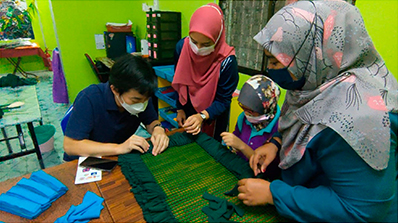
A Japan Overseas Cooperation Volunteer (JOCV) at a support facility for persons with disabilities in Malaysia, hearing about the status of social participation of persons with disabilities while learning original product making (Photo: PDK BANDAR KULIM)
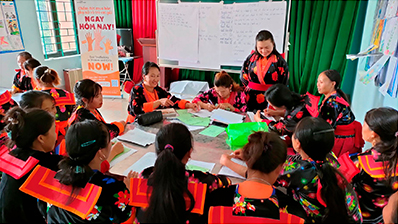
A group of women participating in an activity to learn skills for income generation under the project on “Human Trafficking Prevention for Women and Girls in Dien Bien Province” in mountainous areas of Viet Nam (Photo: World Vision Japan)
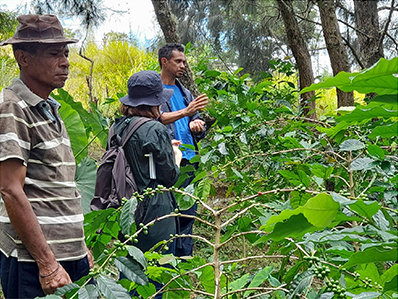
Staff of PARC Interpeoples’ Cooperation (PARCIC) inspecting coffee fields in Timor-Leste, for the purpose of replacing aged trees with new ones and improving soils under the JICA Partnership Program (JPP) “Coffee Field Improvement Project” (Photo: JICA)
ASEAN countries Note 2 are located along Japan’s sea lanes and have strong economic ties with Japan, with approximately 15,000 Japanese companies (business establishments) operating in the region as of October 2021. The ASEAN region is of great importance for Japan both on the political and economic fronts. ASEAN declared the establishment of the “ASEAN Community” (2015) and makes efforts to strengthen connectivity and narrow the development gaps within the region. Moreover, the “ASEAN Outlook on the Indo-Pacific (AOIP)” Glossary (2019) advocates the rule of law, openness, freedom, transparency, and inclusivity as ASEAN’s principles of action, sharing many fundamental principles with a “Free and Open Indo-Pacific (FOIP)” promoted by Japan. At the ASEAN-Japan Summit in November 2020, the “Joint Statement of the 23rd ASEAN-Japan Summit on Cooperation on ASEAN Outlook on the Indo-Pacific” was adopted. The leaders reaffirmed the shared fundamental principles of the AOIP and FOIP and agreed to further reinforce the ASEAN-Japan Strategic Partnership through enhanced practical cooperation and synergy in the four areas outlined in the AOIP (maritime cooperation, connectivity, the Sustainable Development Goals (SDGs), and economic and other possible areas of cooperation). Furthermore, at the ASEAN-Japan Summit held in November 2022, Japan issued a report that outlined progress on Japan’s cooperation for the AOIP (Progress Report) and explained that the total number of concrete cooperation projects had reached 89 since the adoption of the Joint Statement (see also “ODA Topics”).
Japan enhances cooperation in light of ASEAN’s initiatives in this way and has provided assistance through ODA in a range of areas such as infrastructure development, the rule of law, maritime safety, disaster risk reduction, health and medical care, and peacebuilding, focusing on strengthening connectivity and narrowing the development gaps as its pillars of cooperation. Additionally, in light of the increasing importance of leveraging the financial resources of the private sector and Multilateral Development Banks in the area of development, Japan launched the “Initiative on Overseas Loan and Investment for ASEAN” at the ASEAN-Japan Summit in 2019. Under this initiative, Japan contributes to the economic revitalization of ASEAN countries by expanding loans and investment to the private sector in support of SMEs and others in the fields of quality infrastructure investment, improvement of financial access and support for women, and green investment. Moreover, Japan aims to mobilize funding of 3 billion US dollars from the public and private sectors centered on funding for ASEAN over three years from 2019 to 2022, and works on providing loans and investment totaling 1.2 billion US dollars through JICA.
With regard to strengthening connectivity, Japan supports the enhancement of ASEAN connectivity based on the “Master Plan on ASEAN Connectivity 2025,” Glossary which aims to strengthen “physical connectivity,” “institutional connectivity,” and “people-to-people connectivity” in the region. Japan signed the Japan-ASEAN Technical Cooperation Agreement (2019) to encourage ASEAN to consolidate its unity and centrality. In accordance with the Agreement, Japan conducted training on cyber security (see “Cyberspace” for details), marine plastic litter management, public international law, and treatment of criminal offenders by FY2022. Moreover, based on the “Japan-ASEAN Connectivity Initiative” announced in 2020, Japan supports strengthening ASEAN connectivity in both hard and soft infrastructure. For hard infrastructure support, it focuses mainly on projects to strengthen land, sea, and air corridor connectivity totaling approximately 2 trillion yen, while for soft infrastructure support, it focuses on developing human resources who contribute to strengthening connectivity, by training 1,000 individuals over three years from 2020.
In terms of infrastructure development, Japan works to promote quality infrastructure investment based on its past experiences of assisting Southeast Asian countries and in accordance with the “G20 Principles for Quality Infrastructure Investment.” Note 3 One example is the “Technical Assistance Project to Establish of the Philippine Railway Institute (PRI)” assisted through ODA in Metro Manila. As urban railways are being developed in Manila, there is a need for a sustainable system for developing human resources capable of carrying out advanced operations and maintenance of the railways. To correspond to this need, the Government of the Philippines decided to establish PRI as an entity responsible for developing and supervising human resources working for railways. To establish PRI, Japan assisted in the construction of the PRI facility as part of a subway construction project with loan aid, provided simulators and other necessary training equipment with grant aid, and supported institutional building and capacity development through technical cooperation. Through this wide range of assistance, Japan contributes not only to the construction of railway infrastructure, but also to the development of railway maintenance and management capacities and related human resources.
In regard to the disaster risk reduction and disaster health management, since 2009, Japan has continuously contributed to strengthening disaster management and disaster response capacity in ASEAN with support for the ASEAN Coordinating Centre for Humanitarian Assistance on Disaster Management (AHA Centre) through the Japan-ASEAN Integration Fund (JAIF), Note 4 including the establishment of an integrated ICT System, the establishment of a Disaster Emergency Logistic System for ASEAN (DELSA), capacity building of the ASEAN-Emergency Response and Assessment Team (ASEAN-ERAT), and the AHA Centre Executive (ACE) Programme. Japan has implemented the “Project for Strengthening the ASEAN Regional Capacity on Disaster Health Management” (ARCH) Note 5 since 2016 and made many achievements, including holding regional coordination drills for disaster health management teams from ASEAN countries and developing standard operation procedures relating to disaster health management. Through cohosted trainings with the World Health Organization (WHO), Japan also works together to strengthen coordination capacities in the field of disaster health management in the ASEAN region in accordance with global standards for disaster health management teams.
In addition, Japan fully supports the establishment of the ASEAN Centre for Public Health Emergencies and Emerging Diseases, including by contributing approximately 5.5 billion yen (50 million US dollars) to JAIF in 2020. This is part of Japan’s contributions to strengthening the capacity of the ASEAN region to respond to public health emergencies and to prepare for, detect, and respond to emerging infectious diseases. In October 2021 and February 2022, Japan held online training for public health officials from ASEAN countries responsible for the Centre’s operations. Japan also makes arrangements to dispatch experts to the Centre. Additionally, Japan contributed a further 1 million US dollars to the “COVID-19 ASEAN Response Fund,” which aims to develop vaccines and procure medical supplies, on top of its contribution through the ASEAN Plus Three (APT) Cooperation Fund.
Furthermore, with regard to the area of human resources development, Japan works on developing approximately 80,000 people over five years from 2019, including in the digital sector such as AI, under the “Industrial Human Resource Development Cooperation Initiative 2.0” announced at the ASEAN-Japan Summit in 2018. Japan provides support to Thailand in establishing “Kosen schools (Technical Colleges),” which are unique to the Japanese education system and provide Kosen education with the same standards as those in Japan, as part of its contribution to the development of industrial human resources in the ASEAN region. In addition, Japan implements the “Innovative Asia” initiative, which supports the circulation of competent human resources in Asian countries including ASEAN through studying abroad at Japanese graduate schools or other institutions, internships at Japanese companies, etc., with the aim of promoting innovation in Asia including Japan. Over the five years from FY2017 to FY2021, Japan had accepted people from all across Asia under this project.
Japan also engages in economic cooperation, holding investment seminars, invitation programs, and the “BIMP-EAGA+Japan” dialogue for the East ASEAN Growth Area (BIMP-EAGA). Note 6 In 2021, fishing port facilities and a fish market were completed on Biak Island in Papua Province, Indonesia, and in 2022, tuna unloaded from the port were exported to Japan.
With regard to the Mekong region, Note 7 which has great potential for development among the ASEAN countries, the Mekong-Japan Summit Meeting has been held since 2009. Around once every three years, it is held in Japan, where Japan and the Mekong countries adopt an assistance policy for the region.
Japan focuses on the strengthening connectivity critical for economic growth in the region and steadily implements projects under the “Tokyo Strategy 2018,” Note 8 such as the development of the Sihanoukville Port in Cambodia, functional improvements for the Vientiane International Airport in Laos, construction of the Ho Chi Minh City urban railway in Viet Nam, and construction of the Mass Transit System (Red Line) in Bangkok, Thailand.
Based on the “Mekong-Japan Initiative for SDGs toward 2030” announced in 2019, Japan makes use of quality infrastructure investment in line with international standards so as to draw out the Mekong region’s potential in an optimal manner, while focusing its efforts on the three priority areas of (i) environmental and urban issues, (ii) sustainable natural resource management and utilization, and (iii) inclusive growth. As a concrete effort for this, Japan provides support for community-based socio-economic development and the realization of the SDGs in the Mekong countries through the “KUSANONE Mekong SDGs Initiative.” The 1st Mekong-Japan SDGs Forum was held in December 2021, in which participants shared issues and initiatives of each country and exchanged views. Japan will continue to promote the SDGs in the Mekong region based on the “Mekong-Japan Initiative for SDGs toward 2030” in order to make the region more sustainable, diverse, and inclusive.
Furthermore, as Mekong region countries were dealt economic blows by COVID-19, which caused a lack of development financing, Japan promotes the “Five Points of Cooperation,” including the “Mekong SDGs Investment Partnership,” in order to support the implementation of development projects by private companies and others: (i) promotion of loans and investment for the private sector, (ii) Grant Assistance for Grass-Roots Human Security Projects that pervades through small communities, (iii) cooperation concerning the rule of law, (iv) cooperation concerning the ocean, and (v) cooperation concerning strengthening supply chains.
Japan exchanged notes with Cambodia, the Chair of ASEAN in 2022, during the ASEAN-Japan Summit in November concerning support for the provision of equipment necessary for the construction of cybersecurity systems, the first assistance in this area, in addition to the support for landmine countermeasures, water supply, and medical waste management. With Laos, Japan signed an agreement concerning the provision of equipment necessary for clearing unexploded ordnance, as well as a Record of Discussions for the “Project for Integrated Energy Master Plan towards Sustainable Carbon Neutral Society,” which aims to formulate a long-term energy transition masterplan for achieving a carbon-neutral society (the project is set to start in January 2023).
Malaysia
Promotion of KAIZEN in Cooperation with the Government of Malaysia
Enhancing Productivity and Competitiveness through KAIZEN for African Countries
Technical Cooperation (Third Country Training) (2011 – 2022)
Since the 1980s, JICA has been carrying out projects to promote the KAIZEN Note 1 method to contribute to the advancement of industrial development in Southeast Asia. Within the region, KAIZEN has spread widely in Malaysia in particular, contributing to the country’s current economic development.
Malaysia established the Malaysia Productivity Corporation (MPC) in 2008 to strengthen the international competitiveness of Malaysian companies through training and consulting based on the KAIZEN method. Furthermore, the MPC makes use of this experience to promote KAIZEN to other developing countries and carries out activities to support their industrial development.
Meanwhile, in African countries, there was a growing awareness that improving the quality and productivity of the products they produce would be essential for the development of their own industries, and interest in the Japanese style KAIZEN increased. In response to this situation, since 2005, JICA has been providing cooperation to African countries for the improvement of productivity, mainly through the KAIZEN method.
Under such circumstances, since 2011, Malaysia has continued to provide this training to African countries as part of their cooperation for the Tokyo International Conference on African Development (TICAD) Note 2 led by Japan. Specifically, Malaysia invites government officials from African countries and provides training on the theory and practice of “Seiri (Sort), Seiton (Set), Seiso (Shine), Seiketsu (Standardize), and Shitsuke (Sustain)” (5-S Principles), with JICA providing financial and technical cooperation. To date, more than 100 participants from 19 African countries have participated in the training. The training, which makes use of Malaysia’s experience and knowledge, has been highly valued.
This training not only contributes to the development of African countries, but also strengthens the partnership between Japan and Malaysia. It is a meaningful triangular cooperationNote 3 that also contributes to the promotion of Japan’s KAIZEN brand, and Japan will continue these efforts.
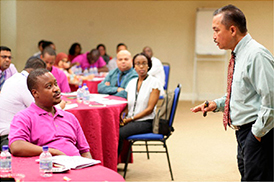
An instructor from Malaysia running a workshop (Photo: JICA)
Note 1: See Note 32.
Note 2: See “ODA Topics.”
Note 3: See the glossary.
■ Assistance for Myanmar
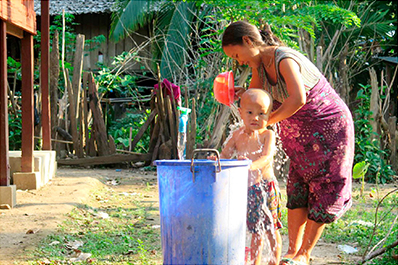
Villagers in Myanmar bathing with water from a tap installed under Japan’s humanitarian assistance (Photo: ©ADRA Myanmar in 2022)
Regarding Myanmar, since the coup d’état in February 2021, the Government of Japan has consistently urged the Myanmar military to take concrete actions to (i) immediately stop the violence, (ii) release those who are detained, and (iii) swiftly restore Myanmar’s democratic political system. There is no ODA project newly established between Japan and the regime led by the Myanmar military since the coup.
On the other hand, the humanitarian situation in Myanmar has deteriorated further due to the spread of COVID-19 and the coup d’état, making humanitarian assistance to the people of Myanmar an urgent issue. Japan actively provides humanitarian assistance through international organizations and other partners to improve the situation. In February 2022, Japan decided to provide support in the areas of food, nutrition, health, water and sanitation, shelter, and protection, as well as to offer oxygen concentrators and personal protective equipment such as masks to respond to COVID-19, through a range of international organizations and the ASEAN Secretariat (a total of approximately 18.5 million US dollars). The implementation of this assistance was sequentially commenced during 2022. In April 2022, Japan also announced the additional emergency assistance and provided emergency supplies including food and shelters, and installed water-related equipment and facilities, through international organizations (8.3 million US dollars). Furthermore, in May 2022, the Government of Japan decided to provide assistance in Myanmar and Thailand through Japanese NGOs via Japan Platform (JPF), in the fields of food and supplies, water and sanitation, health and medical care, protection, and education, which was worth up to 235 million yen, and projects are currently underway. The Government of Japan will continue to pay close attention to the needs of the people of Myanmar, who are facing difficult circumstances, and actively provide humanitarian assistance that reaches the people of Myanmar in need, in partnership with international organizations, the ASEAN Secretariat, and NGOs, taking into account the local situation, humanitarian needs, and level of urgency.
■ Termination of ODA to China
The Government of Japan terminated the provision of new ODA to China at the end of FY2018, and all ODA projects for China were completed by the end of FY2021.
Glossary
- ASEAN Outlook on the Indo-Pacific (AOIP)
- An initiative to create a vision of even closer cooperation in the Indo-Pacific and strengthen ASEAN-centered regional architecture. It is not aimed at creating new mechanisms or replacing existing ones; rather, it is intended to enhance ASEAN’s community building process and to better face challenges arising from the current and future regional and global environments. It shares many fundamental commonalities with a “Free and Open Indo-Pacific (FOIP)” promoted by Japan.
- Master Plan on ASEAN Connectivity 2025 (MPAC 2025)
- An action plan for strengthening ASEAN connectivity that was adopted at the ASEAN Summit in 2016 as the successor to the “Master Plan on ASEAN Connectivity” (adopted in 2010). It is positioned as a part of “ASEAN 2025: Forging Ahead Together” (adopted in 2015). The document stipulates the five strategic objectives of “sustainable infrastructure,” “digital innovation,” “seamless logistics,” “regulatory excellence,” and “people mobility,” and presents priority initiatives under each of the strategies.
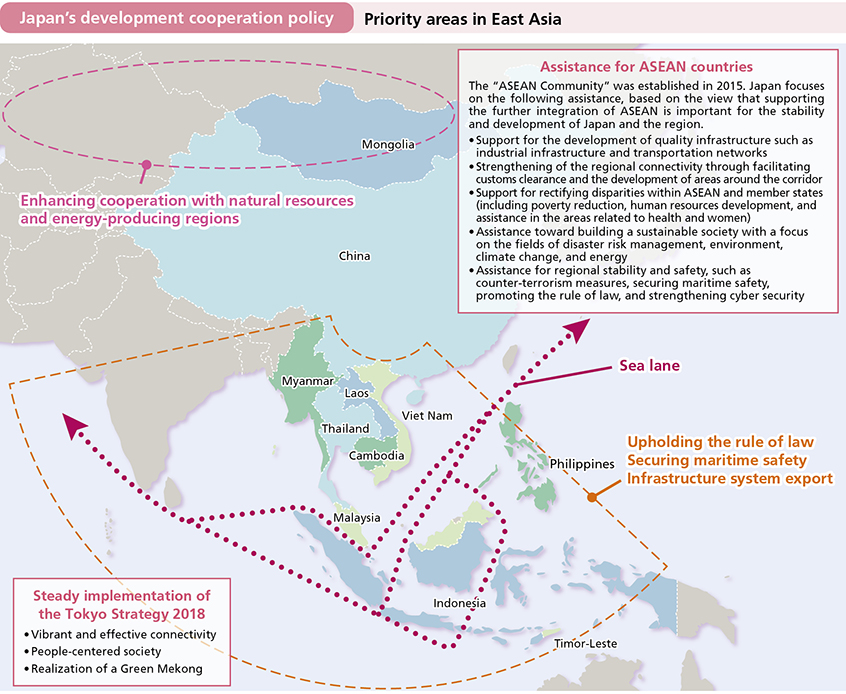
- Note 1: See the glossary.
- Note 2: The 10 ASEAN member states are Brunei, Cambodia, Indonesia, Laos, Malaysia, Myanmar, the Philippines, Singapore, Thailand, and Viet Nam.
- Note 3: See the glossary “Quality Infrastructure.”
- Note 4: A fund established in 2006 to support ASEAN’s endeavors to advance integration by correcting regional disparities, aiming at the establishment of an ASEAN Community. Japan announced its contribution of a total of 7.5 billion yen (approximately 70.1 million US dollars) at the 2005 ASEAN-Japan Summit, and later contributed a total of 100 million US dollars to the “JAIF 2.0” in 2013. Japan provided additional contributions in 2019, 2020, 2021, and 2022.
- Note 5: A project to create a framework to implement the policy of the ASEAN Declaration on “One ASEAN, One Response: ASEAN Responding to Disasters as One” (2014 ASEAN Ministerial Meeting on Disaster Management). In 2017, the “ASEAN Leader’s Declaration (ALD) on Disaster Health Management” (2017) clearly incorporated the need for the activities engaged in through ARCH.
- Note 6: A regional framework established in 1994 by Brunei, Indonesia, Malaysia, and the Philippines to promote economic growth in the developing regions of these four countries.
- Note 7: A region including the five countries of Cambodia, Laos, Myanmar, Thailand, and Viet Nam.
- Note 8: Adopted at the 10th Mekong-Japan Summit Meeting in Tokyo in 2018. It outlines the direction of Japan’s cooperation with Mekong.
